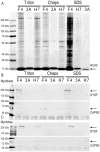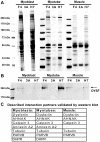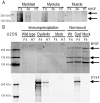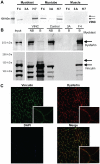Proteomic analysis of the dysferlin protein complex unveils its importance for sarcolemmal maintenance and integrity
- PMID: 21079765
- PMCID: PMC2974636
- DOI: 10.1371/journal.pone.0013854
Proteomic analysis of the dysferlin protein complex unveils its importance for sarcolemmal maintenance and integrity
Abstract
Dysferlin is critical for repair of muscle membranes after damage. Mutations in dysferlin lead to a progressive muscular dystrophy. Recent studies suggest additional roles for dysferlin. We set out to study dysferlin's protein-protein interactions to obtain comprehensive knowledge of dysferlin functionalities in a myogenic context. We developed a robust and reproducible method to isolate dysferlin protein complexes from cells and tissue. We analyzed the composition of these complexes in cultured myoblasts, myotubes and skeletal muscle tissue by mass spectrometry and subsequently inferred potential protein functions through bioinformatics analyses. Our data confirm previously reported interactions and support a function for dysferlin as a vesicle trafficking protein. In addition novel potential functionalities were uncovered, including phagocytosis and focal adhesion. Our data reveal that the dysferlin protein complex has a dynamic composition as a function of myogenic differentiation. We provide additional experimental evidence and show dysferlin localization to, and interaction with the focal adhesion protein vinculin at the sarcolemma. Finally, our studies reveal evidence for cross-talk between dysferlin and its protein family member myoferlin. Together our analyses show that dysferlin is not only a membrane repair protein but also important for muscle membrane maintenance and integrity.
Conflict of interest statement
Figures






Similar articles
-
Dysferlin interacts with tubulin and microtubules in mouse skeletal muscle.PLoS One. 2010 Apr 12;5(4):e10122. doi: 10.1371/journal.pone.0010122. PLoS One. 2010. PMID: 20405035 Free PMC article.
-
The C2 domains of dysferlin: roles in membrane localization, Ca2+ signalling and sarcolemmal repair.J Physiol. 2022 Apr;600(8):1953-1968. doi: 10.1113/JP282648. Epub 2022 Mar 8. J Physiol. 2022. PMID: 35156706 Free PMC article.
-
Dysferlin interacts with affixin (beta-parvin) at the sarcolemma.J Neuropathol Exp Neurol. 2005 Apr;64(4):334-40. doi: 10.1093/jnen/64.4.334. J Neuropathol Exp Neurol. 2005. PMID: 15835269
-
On the role of dysferlin in striated muscle: membrane repair, t-tubules and Ca2+ handling.J Physiol. 2024 May;602(9):1893-1910. doi: 10.1113/JP285103. Epub 2024 Apr 14. J Physiol. 2024. PMID: 38615232 Review.
-
Dysferlin function in skeletal muscle: Possible pathological mechanisms and therapeutical targets in dysferlinopathies.Exp Neurol. 2016 Sep;283(Pt A):246-54. doi: 10.1016/j.expneurol.2016.06.026. Epub 2016 Jun 25. Exp Neurol. 2016. PMID: 27349407 Review.
Cited by
-
The Annexin A2/S100A10 Complex: The Mutualistic Symbiosis of Two Distinct Proteins.Biomolecules. 2021 Dec 9;11(12):1849. doi: 10.3390/biom11121849. Biomolecules. 2021. PMID: 34944495 Free PMC article. Review.
-
Studying protein-protein affinity and immobilized ligand-protein affinity interactions using MS-based methods.Anal Bioanal Chem. 2011 Sep;401(4):1109-25. doi: 10.1007/s00216-011-5207-9. Epub 2011 Jul 14. Anal Bioanal Chem. 2011. PMID: 21755271 Free PMC article. Review.
-
Functional muscle hypertrophy by increased insulin-like growth factor 1 does not require dysferlin.Muscle Nerve. 2019 Oct;60(4):464-473. doi: 10.1002/mus.26641. Epub 2019 Jul 30. Muscle Nerve. 2019. PMID: 31323135 Free PMC article.
-
Membrane damage-induced vesicle-vesicle fusion of dysferlin-containing vesicles in muscle cells requires microtubules and kinesin.Hum Mol Genet. 2014 Apr 1;23(7):1677-86. doi: 10.1093/hmg/ddt557. Epub 2013 Nov 7. Hum Mol Genet. 2014. PMID: 24203699 Free PMC article.
-
Dysferlin interacts with histone deacetylase 6 and increases alpha-tubulin acetylation.PLoS One. 2011;6(12):e28563. doi: 10.1371/journal.pone.0028563. Epub 2011 Dec 8. PLoS One. 2011. Retraction in: PLoS One. 2018 Jan 29;13(1):e0192239. doi: 10.1371/journal.pone.0192239. PMID: 22174839 Free PMC article. Retracted.
References
-
- Anderson LV, Davison K, Moss JA, Young C, Cullen MJ, et al. Dysferlin is a plasma membrane protein and is expressed early in human development. Hum Mol Genet. 1999;8:855–861. ddc087 [pii] - PubMed
-
- Bansal D, Miyake K, Vogel SS, Groh S, Chen CC, et al. Defective membrane repair in dysferlin-deficient muscular dystrophy. Nature. 2003;423:168–172. 10.1038/nature01573 [doi];nature01573 [pii] - PubMed
-
- Bashir R, Britton S, Strachan T, Keers S, Vafiadaki E, et al. A gene related to Caenorhabditis elegans spermatogenesis factor fer-1 is mutated in limb-girdle muscular dystrophy type 2B. Nat Genet. 1998;20:37–42. 10.1038/1689 [doi] - PubMed
-
- Illa I, Serrano-Munuera C, Gallardo E, Lasa A, Rojas-Garcia R, et al. Distal anterior compartment myopathy: a dysferlin mutation causing a new muscular dystrophy phenotype. Ann Neurol. 2001;49:130–134. - PubMed
-
- Liu J, Aoki M, Illa I, Wu C, Fardeau M, et al. Dysferlin, a novel skeletal muscle gene, is mutated in Miyoshi myopathy and limb girdle muscular dystrophy. Nat Genet. 1998;20:31–36. 10.1038/1682 [doi] - PubMed
Publication types
MeSH terms
Substances
LinkOut - more resources
Full Text Sources

